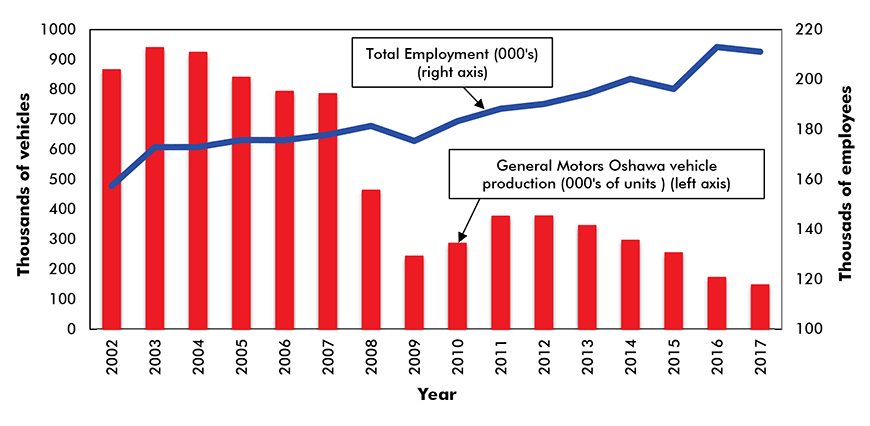Since General Motors announced that it would be shutting down production at five plants in North America including its Oshawa plant, the oldest in Canada, many have painted a gloomy picture of the future of what was once Canada’s Motor City.
However, despite the steady erosion of the city’s largest private sector employer over the past seventeen years, total employment in Oshawa is now 36% higher than it was in 2002.
Indeed over the past year, total employment in Oshawa has risen by 4.9%, the fourth highest increase among Canada’s 33 Census Metro Areas. This increase in total employment has been driven primarily by solid gains in hiring among firms in transportation and warehousing, accommodation services and wholesale trade.
Also, although GM’s auto production in Oshawa has fallen from 786,098 units in 2007 to 148,133 units in 2017, an 81% decline, total employment in the city has increased by 20% over the same period. While the majority of this increase was due to gains in services employment, led by accommodation and food services, wholesale trade, education services and professional services, employment in construction has risen by 15% since 2008.
Despite the solid gain in total employment in 2018, sales of existing homes in Durham region, which includes Oshawa, Ajax, Clarington, Pickering and Whitby, declined by 19% due in large part to the restrictive effect of the mortgage stress test introduced by the federal government at the beginning of 2018.
Consistent with the softening in home sales, the sales-to-listings ratio in the region declined from 54% in 2017 to 49%, indicating a buyer’s market. Median house prices retreated by 4.8% in 2018 following a gain of 13% in 2017.
Given the softer pattern of home sales, it is not surprising that, after posting a 13% increase in 2017, housing starts declined by -11% in 2018. Virtually all of this retreat was caused by a very sharp drop (-59%), in row starts which more than offset gains in single-family units (+8%), semi-detached units (+20%) and apartments (+4%).
The loss of 3,000 jobs at GM will bruise but definitely not break the Oshawa economy. Having said this, heightened uncertainty about the impact of the GM plant closing combined with the prospect of slower growth in the province as a whole (noted in Snapshot #1, “Expect tariffs and taxes to slow but not stall Ontario in 2019”), will likely dampen housing demand through the remainder of this year and into the first half of 2020.
However, the plan to expand GO rail service in the Durham region by adding four stations and 20 kilometres of track will give a significant boost to the regional economy in general and to Oshawa’s prospects in particular.
While the near-term outlook for residential construction in Oshawa is overshadowed by GM-related job losses, the outlook for non-residential construction is considerably brighter. Major projects which should help to offset the lacklustre housing outlook include the construction of four new GO Train stations and associated track extension, Bell Canada’s fibre optic network installation in the city, the ongoing refurbishment of the Darlington Nuclear Generating Station and the Windfields Farms retail and housing development.
This more upbeat outlook for non-residential construction is reinforced by the fact that the value of non-residential building permits issued year to date in 2018 is up by 31% driven by a 61% jump in institutional construction plans, an 18% rise in commercial project approvals and a 7.5% rise in industrial projects.
John Clinkard has over 35 years’ experience as an economist in international, national and regional research and analysis with leading financial institutions and media outlets in Canada.
Oshawa employment vs General Motors vehicle production












Recent Comments
comments for this post are closed